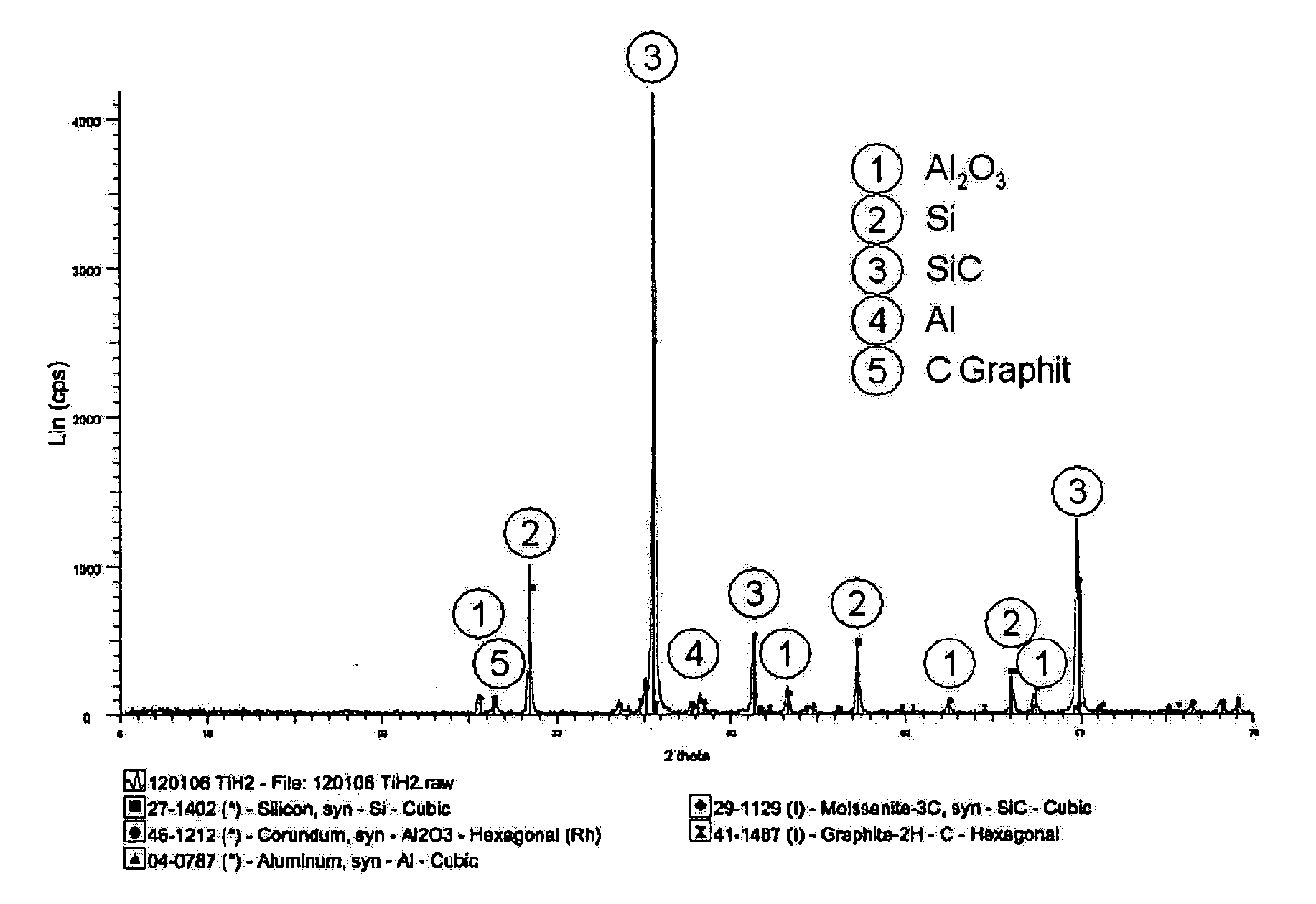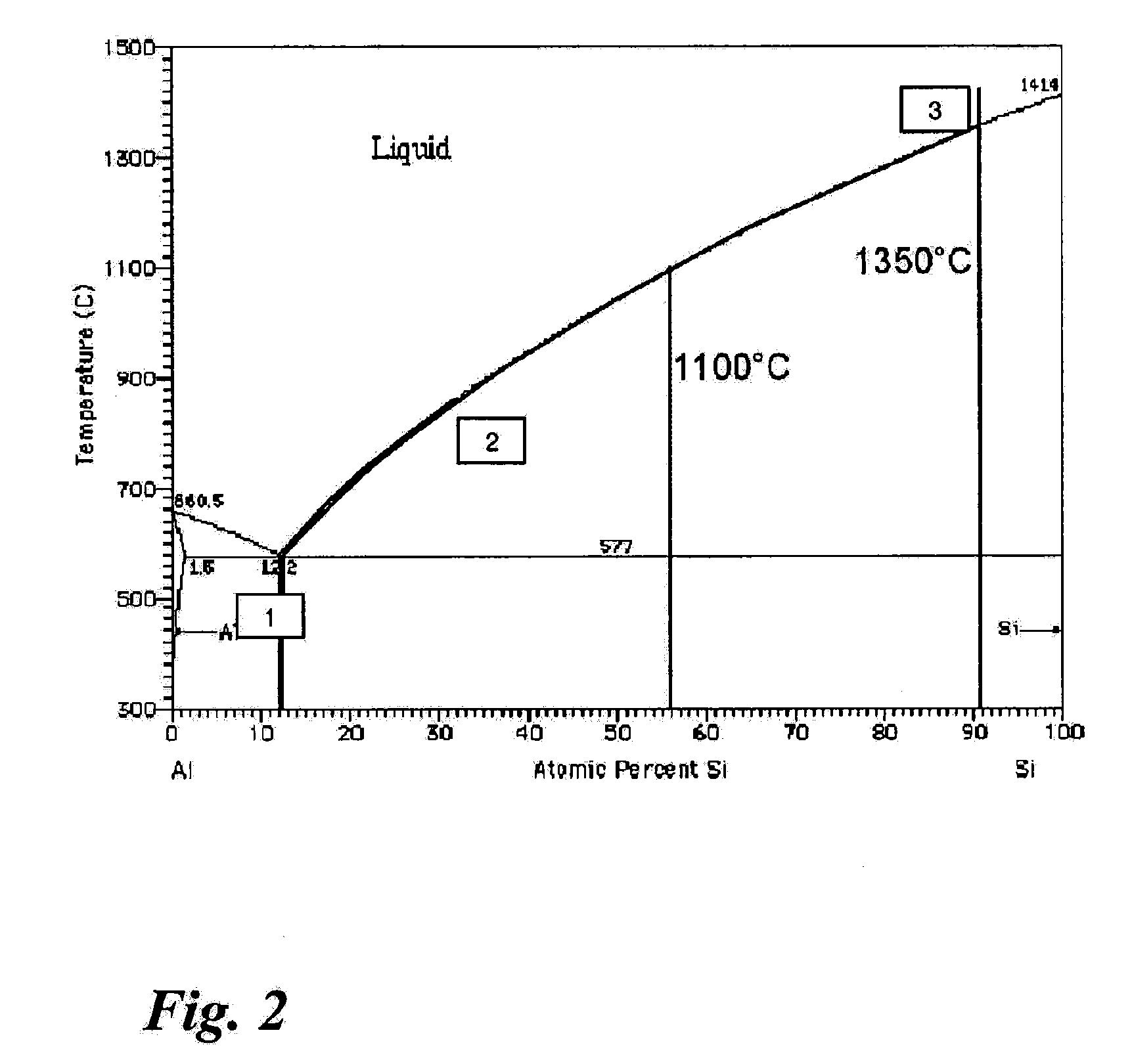Porous beta-sic-containing ceramic molded article comprising an aluminum oxide coating, and method for the production thereof
a technology of aluminum oxide coating and beta-sic, which is applied in the direction of exhaust treatment, filtration separation, lighting and heating apparatus, etc., can solve the problems of high wear and tear of extrusion nozzles, inability to produce stable molded bodies with passage structures, and poor adhesion ability of silicon carbide to catalysts, etc., to achieve high passage density
- Summary
- Abstract
- Description
- Claims
- Application Information
AI Technical Summary
Benefits of technology
Problems solved by technology
Method used
Image
Examples
example 1
[0161]The melting point of aluminum is at about 660° C. The melting point of silicon is at about 1412° C. FIG. 2 shows for a composition with 90 atomic % Si and 10 atomic % Al alloy formation of aluminum and silicon at different temperatures during the pyrolysis and silicating operations.
[0162]During the first temperature procedure (pyrolysis) a eutectic melt involving the composition of 12.2 atomic % Si and 87.8 atomic % Al (point 1 in the diagram) is formed from 577° C. (eutectic point) at the Al-Si contact locations. If the temperature is further increased the melt is increasingly depleted in respect of Al as silicon additionally dissolves. At 850° C. (maximum temperature during pyrolysis in Example 1, point 2 in the diagram) there is theoretically a melt composition of about 33 atomic % Si and 67 atomic % Al. The proportion of Si in the melt however is much too low to permit SiC-formation. During the silicating operation the temperature is raised to a maximum of 1450° C. The pro...
example 2
[0163]FIG. 1 and Table 1 show the ternary Al-Si—C-phase diagram and six possible alloy compositions. Table 1 gives the proportions in atomic %, Table 2 gives them in % by weight. If exactly those proportions are set, the respective melting points of the alloys and thus the corresponding silicating points are reached. The compositions of those alloys are within the Si—SiC—Al triangle, at the Al—SiC connecting line. In order to avoid the formation of the carbide Al4SiC4 that connecting line should not be exceeded in the direction of the SiC—Al4SiC4—Al triangle. If such a carbide were to be formed the mechanical strength of the filter fails greatly and distribution of the aluminum layer becomes less uniform. For that reason the selected proportions in Tables 1 and 2 are also just above that Al—SiC line.
TABLE 1Composition of the possible AlSiC-alloys in atomic %AlSiC1100° C.28.136.535.41150° C.22.938.538.31200° C.18.541.040.51250° C.14.043.242.81300° C.10.345.144.61350° C.5.247.647.2
TAB...
example 3
[0164]Taking the starting material, a honeycomb body with 200 cpsi was produced by extrusion, dried and pyrolyzed at 850° C. The pyrolyzed body was then heated In an argon atmosphere to 1250° C. or 1350° C. and kept at that temperature for 1 hour.
PUM
| Property | Measurement | Unit |
|---|---|---|
| Temperature | aaaaa | aaaaa |
| Temperature | aaaaa | aaaaa |
| Temperature | aaaaa | aaaaa |
Abstract
Description
Claims
Application Information
 Login to View More
Login to View More - R&D
- Intellectual Property
- Life Sciences
- Materials
- Tech Scout
- Unparalleled Data Quality
- Higher Quality Content
- 60% Fewer Hallucinations
Browse by: Latest US Patents, China's latest patents, Technical Efficacy Thesaurus, Application Domain, Technology Topic, Popular Technical Reports.
© 2025 PatSnap. All rights reserved.Legal|Privacy policy|Modern Slavery Act Transparency Statement|Sitemap|About US| Contact US: help@patsnap.com



